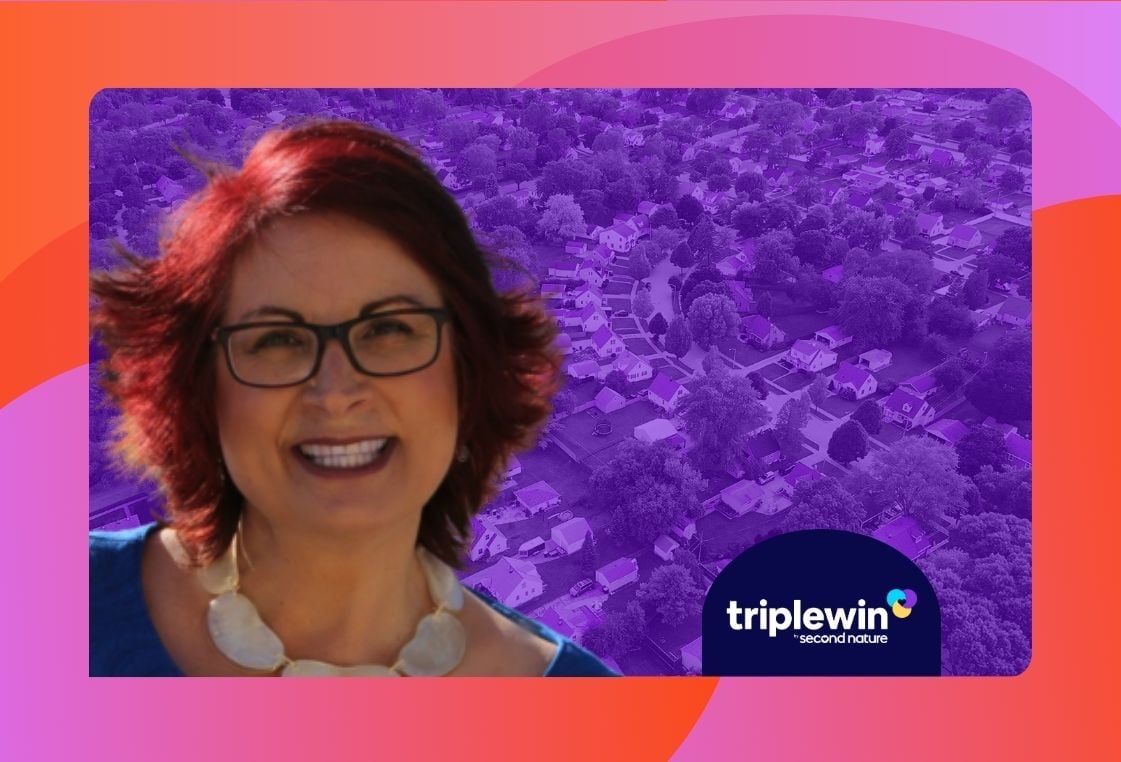What we'll cover
What is a Tenant Move-In Checklist?
Benefits of Using a Tenant Move-In Checklist
How Should a Property Management Company Prepare for Tenant Move-In?
What Should a Property Management Company Provide to the Tenants During the Move-In Process?
What Should a Property Management Company Do on the Day the Tenant Moves In?
Are Property Managers Required to Use a Tenant Move-In Checklist?
How to Create a Tenant Move-In Checklist
What To Do After Completing a Move-In Checklist
Tip to Optimize the Move-In Experience With a Checklist
Free Tenant Move-In Checklist Template
Final Thoughts
We get a lot of questions here at Second Nature about the ideal tenant move-in checklist. After all, whether you're new to the realm of property management or a seasoned expert, one common goal unites us all: creating an excellent resident experience.
The move-in process marks the beginning of your resident’s journey, and it's an opportunity to make a great first impression. A well-crafted resident move-in checklist can make this process smooth, efficient, and stress-free for all parties involved.
In this article, we're talking to a leader in the single-family rental property management space to help us delve into the essentials of a resident move-in checklist, its benefits, and how it can enhance the overall resident move-in experience.
Let's dive in and discover how a simple checklist can streamline your move-ins.
Interested in reading more about resident experience management? Read our State of Resident Experience Report.
Meet the Expert: Janet Sprissler, Broker/Owner, Rent 805
Janet Sprissler has over 20 years of experience in property management and a philosophy of working with residents to bring them value and help communities thrive while providing investors with a positive net operating income. She started her career in Los Angeles with 24 units and grew to a multi-family fixer for over 400-unit buildings throughout Ventura, Los Angeles, and Orange Counties. Janet left multifamily to consult with single-family residential managers to bring her problem-solving philosophy to life. Starting Rent 805 has been a lifelong dream of hers to bring investments, housing, and a positive impact in the property management community.
Janet also received the 2023 Triple Win Property Management Award for Leadership in Resident Experience.
Related: Notice to Vacate Tenant Free Template

What is a tenant move-in checklist?
A tenant move-in checklist is a detailed document that records the condition of a rental property at the time a resident moves in, serving as an essential tool to prevent potential disputes over property damage during the lease period. Some consider this a landlord-tenant agreement but can be between property managers and residents, as well.
This checklist is a lifeline for both property managers and new residents. From the state of the kitchen appliances to the condition of the flooring, this checklist serves as a comprehensive record of the property's state.
Other names for the checklist could include:
Think of it as a snapshot in time, providing a clear reference point for both parties. It's not just a piece of paper; it's a roadmap to a smooth tenancy for everyone involved. Now, that's a win-win!
Note on Language: At Second Nature, we like to say “resident” rather than “tenant,” but will use the terms interchangeably since many property managers have official terminology around these checklists.
Related: How to Write a Tenant Move-Out Letter
Benefits of using a tenant move-in checklist
Using a well-crafted checklist has far-reaching benefits for property owners, property managers, and property residents. We’re breaking down the benefits based on each of these perspectives.
Benefits for property owners
- Protection of property: A move-in checklist includes a detailed property inspection, protecting owners from damage disputes at the end of a lease.
- Compliance with local laws: Some jurisdictions require move-in checklists for legal protection.
- Maintenance tracking: Early identification of maintenance issues can help property owners address them proactively.
Benefits for property managers
- Streamlined process: A move-in checklist provides a clear process, helping property managers to stay organized and ensure all essential tasks are completed.
- Improved communication: A checklist sets clear expectations for the move-in process, promoting transparency and minimizing misunderstandings with residents for the lease agreement.
- Property protection: By signing off on a detailed checklist, property managers ensure their good work is documented and any issues can be clearly identified as resident responsibility. This is critical when it comes to the security deposit if there is damage.
- Increased efficiency: Using a checklist can speed up the move-in process, maintenance before move-in, etc., saving property managers valuable time.
Benefits for residents
- Clarity and transparency: A checklist provides residents with clear expectations of what the move-in process involves and their responsibilities. You will have a document of pre-existing damage and know what repairs are needed, plus what’s just normal wear and tear.
- Peace of mind: A detailed property inspection at move-in provides a record of the property's condition, protecting residents from unjust damage claims. It also helps them ensure any open issues are repaired.
- Smooth transition: A well-organized move-in process can ease the stress of moving, enhancing the resident’s initial experience and ensuring they move into a space that’s ready for safe living.

How should a property management company prepare for tenant move-In?
Making sure the property is ready for the new tenant before they move in, and that the former tenant (if applicable) has a seamless transition out of the property - follow these guidelines to ensure a smooth process and happy tenants.
- Redirect mail: Before your last communication with the former tenant, PMs should notify them they can submit a change of address via USPS so all their mail gets forwarded to their new address with ease.
- Clean the property: The previous tenant will typically clean up the space to some degree before they move out, and PMs will do a rental inspection to review the condition of the rental property. After this process, we recommend scheduling professional cleaning services to spruce up the property and make it move-in ready for new tenants.
- Confirm repairs are completed: Any repairs or maintenance tasks identified in the move-out inspection should be completed before the new tenant moves in.
- Check for safety hazards: Conduct a thorough inspection and fix any potential safety issues, such as exposed wires, tripping hazards, or loose handrails.
- Copy the keys: The former tenant will leave you with a copy of the house keys. Make sure they’re not damaged and test them to make sure they still work properly before handing them over to the new tenant. If you happen to change the locks, be sure to set time aside to create an extra set (or two, just in case the tenant loses one).
- Share appliance instructions: While some of this information would be included in a welcome packet for tenants, it’s helpful to share instructions or operating manuals for some of the appliances to help them understand how to properly care and use them during their tenancy.
- Check landscaping: Make sure the grounds (such as lawns, gardens, and commons) are presentable and well-maintained. This should include reviewing the exterior elements of the property such as the driveway, light fixtures, fence, roof, and gutters. Reach out to your landscaping and maintenance vendors to schedule regular upkeep, unless this is the tenant’s responsibility such as mowing the grass.
- Provide utilities information: Share information about the utilities such as electricity, water, gas, heating/cooking systems, and internet. Make sure they know how to transfer utility bills to their name, as well. You can also include information about a move-in concierge in a Resident Benefits Package through Second Nature.
What should a property management company provide to the tenants during the move-In process?
During the move-in process, property management companies should provide tenants with the following:
Lease agreement
PMs should provide tenants with a copy of the signed lease agreement, which details the overall terms and conditions of the lease. We recommend providing a hard copy, in addition to an electronic one to ensure peace of mind both for the property management company and the tenant.
Related: Lease Management Process
Safety records
Safety records, including smoke and carbon monoxide alarm certifications and any other safety inspections, should be readily available to ease the tenant’s mind. Having this documentation helps make sure the property is up to safety code, as well for the PM.
Smoke alarm and carbon monoxide detectors
In addition to PMs sharing documentation showing that smoke alarms and carbon monoxide detectors are properly installed and functioning, they should also discuss when and how often they may need to be replaced. This is essential to tenant safety and can reduce the risk of fire and carbon monoxide poisoning in the rental property.
Inventory of the property
A detailed inventory of the property, including the condition of furniture, appliances, and other items is helpful for tenants to be aware of. This is the bulk of the checklist, and includes an evaluation of each room's condition, including walls, flooring, windows, countertops, faucets, doors, light fixtures, and any furniture or appliances. More details can be included such as the condition of the paint, if there are any visible carpet stains, and the functionality of the appliances. PMs can take the extra step by providing clear photos of each room to show existing damages so there’s a visual record and to clarify any potential disputes.
Property managers should perform the inventory check with the tenant, and allow them to review this checklist so they can agree on the condition of each item before signing off on it. By dating and signing the document, this confirms their agreement on the property’s initial condition.
What should a property management company do on the day the tenant moves In?
Property managers can start a positive relationship with the tenant by providing a warm welcome on their move-in day and clear communication about the property. Here are some guidelines on what to walk through that first day:
Demonstrate equipment
Tenants are typically aware of how equipment in the property works, such as locks, dishwashers, and washing machines. PMs should check with the tenant if they’d like an overview of anything, to make sure they understand how to use it.
Explain safety equipment
Part of the walkthrough should include an overview of where the safety equipment is so they can be prepared if there’s ever an emergency. This should include an explanation of how to use relevant equipment such as fire extinguishers and blankets, locks, and any security systems.
Provide emergency contact numbers
Tenants should have a list of local emergency contact numbers, as well as main points of contact at the property management company. This should include a written explanation of how to deal with different emergency situations on the property, such as losing power, issues with the HVAC system, or an urgent repair.
Answer questions
Once the walkthrough is complete, tenants should have the opportunity to ask any immediate questions they have about the property or their tenancy. If they have questions later, they can always reach out to the property manager later.
Hand over the keys
Once the property manager has walked through everything and answered all the tenant’s questions, the last step is handing over the keys and making sure they have access to any additional common areas.

Are property managers required to use a tenant move-in checklist?
Sometimes, new tenants must be provided with a written statement on the condition of the unit at move-in time, including a comprehensive list of existing damage.
This varies by state, though. For instance, this applies to all new tenants in Arizona, Connecticut, Hawaii, Kansas, Maryland, Nevada, North Dakota, and Virginia. Yet, in other states, such as Georgia, Kentucky, Massachusetts, Michigan, Montana, Washington, and Wisconsin - this depends on whether a security deposit is being collected.
This process is designed to ensure transparency and fairness, promote better communication, and reduce potential conflicts between the tenant and property management company.
For detailed information on specific state requirements, we recommend consulting local laws or legal resources, particularly since cities and counties may pass local ordinances that affect tenant rights and responsibilities.
How to create a tenant move-in checklist
As hinted earlier, a tenant move-in checklist involves several comprehensive sections to make sure it fully captures the property’s condition. (Don’t worry, we’ll provide a template you can use!) Some of these will include the following section:
- General information: This covers the basics like the property address, the names of the tenants, and the date of the move-in inspection.
- Rooms: This includes noting the condition of each space such as the bedroom(s), bathroom(s), kitchen, living room, and dining area. It typically includes an overview of the conditions of the doors, floors, walls, and windows in each space.
- Appliances: This describes the state of the appliances and fixtures in the property such as microwaves, dishwashers, fridges, washing machines, and outlets.
- Utilities: This includes a review of systems such as plumbing, electrical, HVAC, and making sure the electrical panel is property labeled and connected.
- Safety: In this critical step, a property manager does a walkthrough of safety equipment such as smoke alarms, carbon monoxide detectors, and fire extinguishers. This includes making sure they’re visible and functioning properly.
- Exterior: An overview of the exterior features of the property, such as the front walkway, front porch, rear deck, yard, driveway, security lighting, and any outdoor structures.
What to do after completing a move-in checklist
Once the move-in checklist has been properly filled out and completed, the property manager can wrap up the final steps of the process.
The first step is to go over the details of the checklist with the tenant to make sure they understand it and agree with the property manager’s assessment on the conditions of everything in and around the property. If they disagree about any of the items, the property manager should discuss it with them immediately so they’re both in agreement before they sign off on it. Once the tenant has approved this, make sure they sign and date the checklist as well as the property manager.
A copy of the signed checklist should be given to the tenant once they’ve signed it, and then the property manager should retain the original and copy for their own records.
If the tenant has any repair requests, they should be able to share them by reaching out to the property manager directly or submitting a ticket through the property management portal.
Tip to optimize the move-in experience with a checklist
A checklist is the foundation of a wonderful move-in experience. But it’s just the starting point. How does a property management company set itself apart from others in the move-in experience?
Here’s where we went to Janet Sprissler and others in our Triple Win Property Managers community for input.
Use the right tools
It’s easy to forget a step if you don’t have tools that help automate your process and keep your whole team on the same page.
The most important thing? “You don’t forget a step!” Sprissler says.
“Without a checklist, you’re pretty much setting yourself up to fail,” she continues. “You will drop things, things will be missed, they’ll move in, and there’s going to be a problem. When you set the tone that ‘this is going to be a hot mess,’ you’re setting yourself up to have disgruntled residents, and disgruntled residents never take care of the property well.”
Sprissler especially recommends Monday.com for tracking the checklist and process with your internal team and tools like Tenant Turner to help on the resident side. They use zInspector to ensure they are on top of property inspections.
“I’m not big on a bunch of papers around,” she says. “I want to see it all automated, I want any of my team members to be able to dive into Monday.com and see what’s missing or needed right away. That system runs so much, I’m a huge fan of it.”
Treat all residents with equal care
Sprissler says focusing on making residents feel that “WOW!” is critical to their longevity and care for the property.
At her company, they focus on seamless processes, transparent communication, and even gifts! The key is that every resident gets that same treatment.
“New residents MUST have a move-in gift,” Sprissler says. “They must all get the procedures we’ve set ahead of time. They must receive their birthday gift, they must receive access to our First of the Month Club. We do a move-in concierge through Second Nature – they must have that touch point. We don’t ever say, ‘Hey, this is going to happen,’ and then it doesn’t happen.”
Design the ideal move-in process
We asked Sprissler how they create an ideal resident experience throughout the move-in process, and this was her top recommendation.
“We make it seamless. SEAM. LESS,” she said for emphasis! “On the move-in side, our new residents go through Tenant Turner to get onto the property with an access code. Move in and move out is on Tenant Turner. We make it very simple for them to get access to the property. We don’t play around with it.”
“At every stage of the process, prospective and new residents have had conversations with us so that they’re set up, and they know what’s going to happen next.”
For Sprissler, it’s about thoughtful touches that give residents a sense of a VIP experience. “For example, people get hungry!” Sprissler says. “We have pizzas delivered on a moving day. One of our move-in questions is ‘What’s your favorite pizza?’”
Be willing to go above and beyond
Added touches – like the pizza on move-in day – go a long way to establishing the best resident experience and behavior.
“When tenants have those touches, it makes life better. It just does,” Sprissler says.
They provide birthday gifts and move-in gifts and will add items for pets or children customized to those residents.
“People often say, ‘How are you recouping that?’” Sprissler says. “I’m recouping that by having great units when I walk through the door. You cannot pay someone to take care of a unit. But if they feel the worth of themselves and how you feel about them, they take great care of the unit.”
Provide a move-in concierge
Second Nature includes a move-in concierge as part of the Resident Benefit Program.
Sprissler says this is one of the best parts of a seamless move-in.
“We use a move-in concierge through Second Nature,” Sprissler says. “People really like it when they’re being reached out to, and all of that is handled. Moving is one of the top five stressors people experience in life. You have to realize as a property manager that you have to take some of that pressure off them. Take it off their plate! Are you making a better experience by piling stuff up on them?”
“When people come into my office and say this is the best experience I’ve ever had, I know we’ve done our job,” Sprissler says.
If you're providing Group Rate Internet as part of the lease, make sure that your residents are properly informed and know to contact Second Nature in order to get connected.
Provide a renter’s insurance program
Making sure that residents have insurance coverage from day one is key. You never know when something could happen, and protecting residents is the foundation of a good experience.
Second Nature’s RBP includes a renter’s insurance program that has 100% compliance across its use. Sprissler is one of the people who use this program, and she says it’s critical to have for her residents.
Set clear expectations and incorporate incentive fees
Sprissler recommends requesting a tenant ledger so you have the clearest information about the resident before move-in.
“You can see if they’ve been charged for maintenance requests, you can see what day they pay – it really is a black and white of how they treated that previous unit,” she says.
And then, of course, that clarity should be reciprocated. Sprissler emphasizes transparency upfront and excellent follow-through. Be clear, but also show that you are willing to listen.
“Say what you mean and mean what you say,” Sprissler says. “I have Rent 805 rules and regulations, and any delinquency is heavily fined. Those are behavioral fees. For example, my late fee is very high, but then it’s also part of my resident benefit package to forgo that one time during the life of the tenant being in the unit. It just sets expectations.”
Ultimately?
“If you use good software that does a good job of screening, these questions are all resolved for you.”
Free tenant move-in checklist template
To help streamline the move-in process and ensure clarity for both property managers and tenants, we’ve provided a free tenant move-in checklist template.
This comprehensive checklist covers all essential areas of the property and helps document its condition at the time of move-in. Property managers can feel free to customize the checklist to their specific needs. We also recommend getting legal guidance to make sure you’re covering all your bases.
Tenant Move-In Checklist
Property Address:
Tenant Name(s):
Move-In Date:
General Information
- Property Address:
- Tenant Name(s):
- Move-In Date:
Living Room
- Walls:
- Floors:
- Windows:
- Doors:
Kitchen
- Walls:
- Floors:
- Windows:
- Doors:
- Appliances:
- Refrigerator:
- Stove/Oven:
- Dishwasher:
- Microwave:
Bedrooms
- Walls:
- Floors:
- Windows:
- Doors:
- Closets:
Bathrooms
- Walls:
- Floors:
- Windows:
- Doors:
- Fixtures:
- Sink:
- Toilet:
- Shower/Bathtub:
Utilities and Systems
- Plumbing:
- Electrical:
- HVAC:
- Internet:
Safety Equipment
- Smoke Detectors:
- Fire Extinguishers:
- Carbon Monoxide Detectors:
Exterior
- Yard:
- Driveway:
- Outdoor Structures:
Signatures
- Tenant Signature:
- Property Manager Signature:
Date:
Final thoughts
Remember, a move-in checklist is not just a document; it's a tool to enhance communication, establish expectations, and create a positive resident experience.
Our top recommendation for ensuring a world-class resident experience is to build a resident benefits program. Second Nature has pioneered the only fully managed Resident Benefits Package for single-family property managers.
Learn more about resident experience management in our State of Resident Experience Report, or explore the benefits of a Resident Benefits Package.
Topics:




